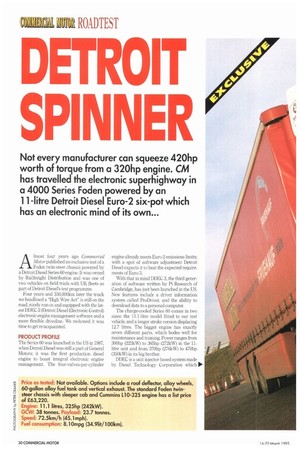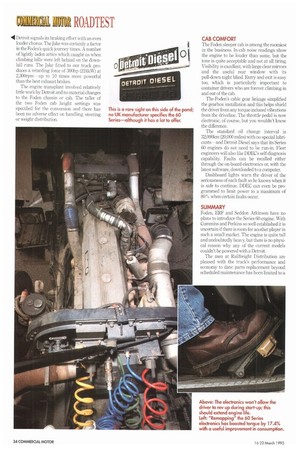DETROIT
Page 32

Page 34

Page 36

If you've noticed an error in this article please click here to report it so we can fix it.
SPINNER
Not every manufacturer can squeeze 420hp worth of torque from a 320hp engine. CM has travelled the electronic superhighway in a 4000 Series Foden powered by an 11-litre Detroit Diesel Euro-2 six-pot which has an electronic mind of its own...
Almost four years ago Commercial Motor published an exclusive test of a Foden twin-steer chassis powered by a Detroit Diesel Series 60 engine. It was owned by Railfreight Distribution and was one of two vehicles on field trials with UK fleets as part of Detroit Diesel's test programme.
Four years and 350,000km later the truck we headlined a "High Wire Act" is still on the road, nicely run-in and equipped with the latest DDF,C-2 (Detroit Diesel Electronic Control) electronic engine management software and a more flexible driveline. We reckoned it was time to get re-acquainted.
PRODUCT PROFILE The Series 60 was launched in the US in 1987, when Detroit Diesel was still a part of General Motors; it was the first production diesel engine to boast integral electronic engine management. The four-valves-per-cylinder engine already meets Euro-2 emissions limits; with a spot of software adjustment Detroit Diesel expects it to beat the expected requirements of Euro-3.
With that in mind DDEC-3, the third generation of software written by Pi Research of Cambridge, has just been launched in the US. New features include a driver information system called ProDriver, and the ability to download data to a personal computer.
The charge-cooled Series 60 comes in two sizes: the 11.1-litre model fitted to our test vehicle, and a longer stroke version displacing 12.7 litres. The bigger engine has exactly seven different parts, which bodes well for maintenance and training. Power ranges from 300hp (223kW) to 365hp (272kW) in the 11litre unit and from 370hp (276kW) to 470hp (350kW) in its big brother.
DDEC is a unit injector-based system made by Diesel Technology Corporation which used to be wholly owned by Detroit Diesel but is now 50% owned by Bosch. The unit injectors are driven by extra lobes on the engine's overhead camshaft. DDEC offers a number of advantages over mechanically governed engines.
As well as integral cruise control, speed limiting and turbocharger protection on start up, options include automatic power reduction and shutdown to prevent damage from low oil pressure or overheating.
DDEC even avoids black smoke by anticipating gear changes and adjusting fuelling to a pre-programmed "no-smoke" mode, and the software automatically adjusts in response to engine wear.
Turn the key and three lights are illuminated along with the usual warning lamps. These are the check and stop warnings while DDEC runs an internal diagnostic check. The driver can start the engine after a few seconds.
There's no need to use the throttle when firing up—in fact drivers who like to start with a roar are prevented from doing so. Like the Cummins Celect and Volvo electronically controlled FH12 engines, the Detroit sticks to its own carefully controlled wake-up procedure to prolong engine and turbo life. Temperature sensors set the idle speed between 600rpm and 1,200rpm depending on the engine's needs. Once warm, tickover is kept to 600rpm.
Electronic engine governing comes in handy for driving PTOs as DDEC maintains constant engine speed under varying loads. Another benefit is the exceptionally high torque output, which helps prolong clutch life because tickover is all you need when pulling away and for most low-speed manoeuvring.
Understandably DDEC-2 has grabbed the headlines, but Detroit has not neglected other aspects of the engine, and Foden has also been busy since we first drove this truck in 1991.
Then, the engine was rated at 320hp with a minimum torque rating of 1,1501bft. Now DDEC has been "re-mapped", increasing torque by 17.4% to a whopping 1,3501bft at 1,200rpm, Peak power has risen by a more modest 1.6% to 325hp with a rated speed down 100rpm to 1,800rpm. A typical European engine needs between 380hp and 420hp to develop that much torque; this setting is more typically American or Australian and very good it feels too.
In 1991 the Detroit Diesel's power was handled by a nine-speed Eaton constant-mesh gearbox and 4.3:1 Rockwell S160E drive axle. They've been superseded by Eaton's 12-speed Twin Splitter and a faster ratio (3.9:1) Rockwell S180E which is ready to go into service at 94 tonnes.
The truck is a standard 1990 Foden 4000 which is little different from the latest 4000 Series models except for its suspension---current twin-steer Fodens have full electronically controlled air suspension (ECAS) at the back. Despite its age and a demanding job we found little to find fault with; the cab was rattle free and the brakes were responsive.
PRODUCTIVITY In 1991 we completed GM's three-day Scottish test route at a brisk 71.7km/h but fuel consumption was an uninspiring 6.92mpg (40.81it/100km). Our tester reckoned that consumption suffered from lack of torque and the nine-speed box. He stuck his neck out and predicted that "the more suitable 13-speeder would have produced up to an 0.8mpg improvement in economy over the whole route". This time round our speed was up to an impressive average 72.5km/h, despite the 56mph motorway speed limit, and our prediction about fuel consumption turned out to be on the conservative side.
Pulling an identical Fruehauf trailer in near identical weather, overall fuel consumption was 8.1mpg (34.91A/100km). The thriftiest truck to date around our Scottish route is Volvo's FH12 420, which managed 8.39mpg (33.71it/100km). But the Volvo was also slower, at an average 70.5km/h. Let's just say that both contenders rank at the very top of the 38tonner productivity league table.
The Foden's economy was better on each day and at every stage of the test. It was aided on the flatter stretches by DDEC's cruise control_ All Series 60 engines growl wonderfully. Switch in the Jake Brake and the
44IDetroit signals its braking effort with an even louder chorus. The Jake was certainly a factor in the Foden's quick journey times. A number of lightly laden artics which caught us when climbing hills were left behind on the downhill runs. The Jake fitted to our truck produces a retarding force of 300hp (224kW) at 2,300rpm up to 10 times more powerful than the best exhaust brakes.
The engine transplant involved relatively little work by Detroit and no material changes to the Foden chassis or cab. The taller of the two Foden cab height settings was specified for the conversion and there has been no adverse effect on handling, steering or weight distribution.




















































































































